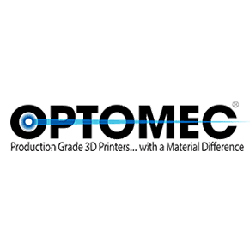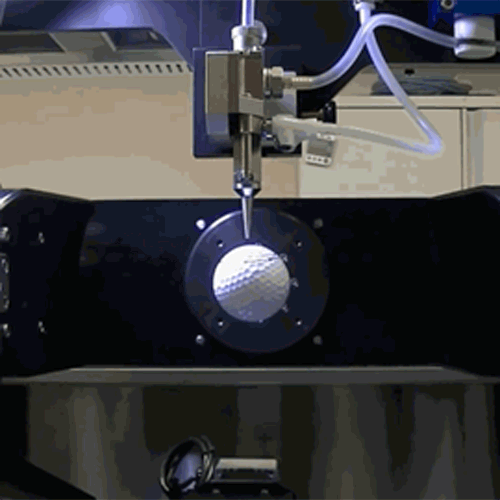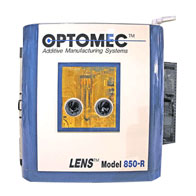I spoke with one of Optomec’s directors about how the company is applying 3D printing to mass production, 3D printing electronics, enabling the Internet of Things, Industry 4.0 and nano-materials such as graphene.
Away from the frenzied noise of press releases about new Kick starters and companies announcing the latest 3D printing “world first” there is a quiet revolution taking place in manufacturing and Albuquerque’s Optomec are well positioned to play a central role.
“The distinction with Optomec is that we have been focused on volume manufacturing and how we bring additive manufacturing to volume production and mass production almost from our outset,” Optomec’s Ken Vartanian tells me. That outset took place in 1997 when David Keicher left Sandia National Laboratories (SNL) to join the company. Keicher was working in the laser materials process group at SNL and saw how breakthroughs by the lab might be applied to manufacturing. Optomec were quick to license the SNL technology and began the task of commercialization and growing the company into a viable international business. With a reported 70% increase in revenue in the most recent financial statements and an order book filled for 6 months it looks like the company’s $35 million investment in R&D is paying off. As Dave Ramahi, CEO, puts it, “Our solid growth in 2015 gives evidence that industrial adoption of high volume additive manufacturing is now a reality at leading corporations.”
LENS and Aerosol Jet
This growth is driven by the growing reputation of Optomec’s two core propriety technologies, LENS and Aerosol Jet. Ken Vartanian has been in the high tech industry for most of his working life and having spent the past decade at Optomec he is well positioned to explain how the company’s 3D printers work. “There are really two conventional ways of making metal parts from powder. One is called powder bed, where a layer of powder is deposited and selectively sintered with a laser, then another layer of powder is deposited on top and sintered, and the process continues layer by layer,” he says. Describing Optomec’s LENS technology he continues, “The second way to 3D Print metal parts using powder is called directed energy deposition. In this case the powder is blown from nozzles, either co-axial or angled with respect to the focal point of a high powered laser so the blown powder creates a melt-pool of molten metal. That molten pool of metal is then moved around the XYZ axis to follow the pattern that is described in the CAD model to create a part layer by layer.”

A hybrid 3D printing technique
The hybrid approach to additive manufacturing came about, like many of the most exciting advancements in 3D printing, via the America Makes program. In 2012 Optomec became a founding member of the organization and later deepened their involvement to that of the highest level of membership, Platinum. Vartanian explains, “About 2 years ago America Makes issued a project call to see how industry could make additive manufacturing more accessible to end production use.” This resulted in substantial research by Optomec looking at the barriers to widespread adoption of 3D printing. Vartanian says, “The biggest barrier we determined is the high cost of industrial additive manufacturing equipment for metal – often in excess of $1,000,000.” To address this Optomec consulted with potential customers and found two factors were the key drivers.
“One is the low volume of additive manufacturing systems sold today for making metal parts ” explains Vartanian. “There were about 800 additive manufacturing machines sold worldwide for producing metal parts in 2015 according to Wohlers Associates. Although this represents a substantial growth rate compared to 2015, the volume of subtractive CNC machine tools sold annually is orders of magnitude higher. The high volume of CNC machines creates an economy of scale and as a result the build cost per machine is much lower than an industrial 3D printer. The second observation was the wide range of standard CNC machine sizes and shapes available. Like most other suppliers of metal 3D printing systems, Optomec produce a limited range of machines. Vartanian explains, “Invariability when we would meet with customers they would ask, ‘can you make your machine a little wider, or a little taller’ to accommodate our part size and of course that customization adds more cost to an already expensive system.” These insights prompted the company to consider how to leverage the, “Much larger canvas of available CNC machine tools that could be adapted with additive manufacturing technology providing a more flexibility and lower cost solution for our customers. This became very attractive to us,” sums up Vartanian.
“From our vantage point LENS directed energy deposition is a more flexible metal additive manufacturing approach that has not, in my opinion, been fully recognized or exploited by industry,” says Vartanian. To address this Optomec took its propriety powder feeder technology, deposition heads, lasers, process controls, and software, and packaged that all into what they call the LENS print engine. “About a year and a half ago we demonstrated a successful integration with a vintage CNC machine tool and since then we have integrated the LENS print engine into numerous CNC machine tools,” says Vartanian. The company has high expectations for this approach, as Vartainian says, “which will lower the adoption cost for metal additive manufacturing and speed industrial adoption.
“We have customers who have implemented the LENS Print Engine in other applications that don’t involve CNC machine tools too. In some cases we’ve integrated LENS metal additive manufacturing technology with robots in a work cell or in laser welding systems for precision repair applications,” says Vartanian and then proceeds to give examples of how customers are using LENS 3D printing. “One of our customers, the Center for Remanufacturing and Resource Recovery (C3R) at the Rochester Institute of Technology, is using LENS Print Engine technology integrated with a CNC vertical mill to repair and remanufacture military components. C3R is one of the world leaders in remanufacturing, which involves manufacturing or restoring worn or damaged in-service parts. The LENS process can either fully build 3D metal parts, when replacement parts are no longer available, or selectively and precisely add materials onto an existing metal component of almost any 3-dimensional shape making it also ideally suited to perform repair/restoration operations. The LENS hybrid CNC machine provides a cost effective tool enabling C3R to perform most or all of remanufacturing/restoring operations on one platform.”
A $75 billion market opportunity
With this approach to the market Optomec are confident they can lower adoption barriers and access a substantially larger customer base than might be served by developing its own additive manufacturing automation platforms. “The number of CNC machine tools that are sold every year are quite large valued at over $75B in 2015 according to the Gardner World Machine-Tool Output & Consumption Survey. Our estimate is over time approximately 5-10% of those machines will have integrated additive manufacturing capabilities,” says Vartanian. But this is not the only 3D printing technology available from Optomec, the company also supplies 3D printing systems that target the electronics market.
Aerosol Jet is, “A new printing technology developed in early 2000 as a result of a [U.S.] Department of Defense request looking at new printing technology that could be used for printing electronics on 3D surfaces, on low temperature substrates and using a wide variety of electronic materials,” explains Vartanian. He continues, “Printing technology has been around for quite a while and technologies such as ink-jet and screen printing have been adapted for use in the electronics industry. But these technologies have their limitations in terms of the materials they can print and as well they were primarily developed to print on flat objects, like paper. So consequently, Aerosol Jet technology was developed as a new printing technology to address these limitations. Two features of Aerosol Jet 3D printing set the technology apart from other methods. “The input mechanism is very unique which allows printing of a wide variety of materials. And the output mechanism is very unique as well in that it allows conformal printing over a variety of surfaces, either flat or non-planar,” says Vartanian.
Nano-particle inks
“The way the process works is a commercially available material in liquid form is atomized to form a dense mist of material laden droplets. A wide variety of materials is supported by the process including metal nano-particle inks, diluted thick film pastes, thermosetting polymers such as UV-curable epoxies, and solvent-based polymers like polyurethane and polyimide. Basically any material that can be suspended in a solution and atomized can be processed with Aerosol Jet technology” Vartanian explains. For conductive metal inks, there are thousands of nanoparticle contained inside each droplet. The nanoparticles typically used in the inks are around 50-100 nm (nanometers) in diameter and the droplets produced by the atomizer are 2-5 microns in diameter. So each droplet encapsulates thousands of nanoparticles. After atomization the dense mist of material is delivered to the print head where a sheath gas is introduced to compress and focus the mist. The sheath gas also serves to insulate the nozzle from the mist to prevent clogging. Also by controlling the gas flow the mist can be compressed into a tight beam, enabling dynamic focusing of the material as it exits the nozzle.” For example, an Aerosol Jet printer fitted with a 100 micron diameter nozzle can be controlled to produce a beam ranging down to 10 microns by adjusting the gas flow.
When the material exits the nozzle it is travelling approximately 70 meters per second. Due to the high speed, “it remains collimated [parallel or all lined up] during its travel from the exit of the nozzle to the substrate for a distance up to 5 mm. A better way to describe it is to say the Aerosol Jet beam of material has a long focal length. This allows Aerosol Jet to print onto irregular or non-planar surfaces and maintain feature resolution,” explains Vartanian. Optomec approached the technology in a similar manner to LENS, “We do sell standalone systems that can be used for education, R&D and low-volume production but we also have packaged Aerosol Jet core technology into a print engine for integration with commercial automation platforms. Aerosol Jet technology is a very scalable for high-volume production applications,” he says.
3D printing smartphones
Phone cases and other maker projects are popular desktop 3D printing projects, but Optomec are now printing the electronics inside these devices. Vartanian gives an example of how 3D printing is already in use in mass production. “Lite-On Mobile Mechanical SBG is a very large electronics contract manufacture and have operations around the world, one of which is in Guangzhou, China. They have a number of our machines in Guangzhou China operating 24/7 printing electronics onto mobile devices, such as smartphones, actually used within the smartphone. They do work for some of the leading brand cell phone OEMS. Roughly about a year ago now we delivered multiple machines that have been operating 24 hours a day, 7 days a week printing electronics onto millions of cell phone cases. We are printing electronics in a conforming manner on the edges and inside the cover using a 5 axis CNC machine tool platform. Each machine is equipped with multiple print heads which can quickly be swapped out during cleaning cycles. It is a very good partnership we have with Lite-On Mobile, they have done an excellent job deploying this technology and attuning it to their process needs. We work very closely with them. They are getting very good yields, costs are on target and their Aerosol Jet production method, which they call 3DP, is a green process eliminating the need for plating.”
3D printing electronics brings a number of benefits, “It boils down to 4 components: flexibility, speed, cost and environmental impact. All of which are important but if you can’t build it cheaper with additive manufacturing, or at least no more expensive than the current manufacturing method, then introducing a new manufacturing process is very difficult.” says Vartanian. The old process used at LITE-ON to manufacture cell phone electronics required plating and used a number of toxic and potentially hazardous chemicals. “3DP is an environmentally friendly solution as it requires no plating or nickel, produces very little process waste” say Lite-On Mobile.
“A large percentage of the electronics in a smartphone can be manufactured with additive manufacturing today. For example sensors, antennas, 3D interconnects for stacked die, and capacitive grids/circuitry for touch screen displays have all been printed using Aerosol Jet technology,” Vartanian says. The technology also has applications for the Internet of Things. “The IoT is a large market opportunity for Aerosol Jet printing. The notion of smart/connected devices applies equally to consumer and industrial products. For example, condition based maintenance for industrial products such as Gas Turbine Engines can be enabled by printing conformal sensors onto turbine blades. These sensors can then be used to monitor dimensional change in the blade which is an early indicator of potential failure. Aerosol Jet is in pre-production use for this application today.”
Graphene and nano-materials
Graphene is a nano-material with attractive properties including high conductivity and remarkable strength. However integrating the material into applications where the benefits of those properties are fully harnessed has proved problematic. Applications of graphene include flexible electronics or improved energy storage for electric cars. Vartanian says, “We have several customers who use Aerosol Jet to deposit either graphene, graphene oxide, or Carbon Nano Tubes. For graphene / graphene oxide they are using commercially available materials and also from research institutes. Typical applications are thin film conductors with thicknesses ranging from 50nm to ≤1um.”
Optomec is a great example of company driving the cluster of technologies that make up Industry 4.0. 3D printers will both perform the manufacturing in smart factories and technologies such as Aerosol Jet will enable the interoperability of machines to communicate with each other across the Internet of Things. Hybrid manufacturing extends the capabilities of traditional techniques, while working with nano-materials is an exciting new frontier. Given this surge in activity, reports of the death of 3D printing are greatly exaggerated.





